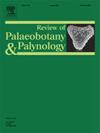Mid-Pleistocene pollen types of the Brazilian Atlantic Forest (Colônia, São Paulo, Brazil)
IF 1.7
3区 地球科学
Q2 PALEONTOLOGY
引用次数: 0
Abstract
We present 146 types of fossil palynomorphs deposited in Mid-Pleistocene sediment in the basin of Colônia, SE Brazil, with the aim of improving our knowledge of past plant diversity of the Atlantic Forest. Morphological description, photographs and ecological information are given for Algae (one type), Bryophyta (one type), Pteridophyte (nine identified and four non-identified types), Gymnosperms (three types), Nymphaeales (one type), Magnoliids (two types), Monocots (nine types) and Eudicots clade (116 types). The most represented botanical families in number of types are Asteraceae, Euphorbiaceae, Fabaceae, Malvaceae, Rubiaceae and Sapotaceae. Our inventory highlights palynomorphs associated with ombrophilous forest physiognomy during the Mid-Pleistocene. We identify key palynomorphs related to modern distribution, such as Araucaria and Podocarpus, both rare in the current vegetation of the Colônia region, while Acaena, Caryocar, and Ephedra are absent. Additionally, moisture-affinity taxa, like Isoetes spores, indicate a lacustrine environment. This catalog will serve as a valuable tool for research extending beyond the Colônia basin to Atlantic Forest palynology broadly.
巴西大西洋森林中更新世花粉类型(Colônia,巴西圣保罗)
本文介绍了巴西东南部Colônia盆地中更新世沉积物中沉积的146种苔藓植物化石,旨在提高我们对大西洋森林过去植物多样性的认识。给出了藻类(1种类型)、苔藓植物(1种类型)、蕨类植物(9种已识别和4种未识别类型)、裸子植物(3种类型)、仙女科(1种类型)、木兰科(2种类型)、单子叶植物(9种类型)和菊科(116种类型)的形态描述、照片和生态信息。在类型数量上最具代表性的植物科是菊科、大戟科、豆科、锦葵科、茜草科和仙人掌科。我们的清单突出了中更新世与无亲缘森林地貌相关的地貌。我们发现了与现代分布相关的关键形态,如Araucaria和Podocarpus,它们在Colônia地区的当前植被中都很少见,而Acaena, Caryocar和Ephedra则缺失。此外,水分亲和性分类群,如Isoetes孢子,表明湖泊环境。该目录将作为一个有价值的工具,从Colônia盆地扩展到大西洋森林孢粉学的广泛研究。
本文章由计算机程序翻译,如有差异,请以英文原文为准。
求助全文
约1分钟内获得全文
求助全文
来源期刊
CiteScore
3.50
自引率
21.10%
发文量
149
审稿时长
6 months
期刊介绍:
The Review of Palaeobotany and Palynology is an international journal for articles in all fields of palaeobotany and palynology dealing with all groups, ranging from marine palynomorphs to higher land plants. Original contributions and comprehensive review papers should appeal to an international audience. Typical topics include but are not restricted to systematics, evolution, palaeobiology, palaeoecology, biostratigraphy, biochronology, palaeoclimatology, paleogeography, taphonomy, palaeoenvironmental reconstructions, vegetation history, and practical applications of palaeobotany and palynology, e.g. in coal and petroleum geology and archaeology. The journal especially encourages the publication of articles in which palaeobotany and palynology are applied for solving fundamental geological and biological problems as well as innovative and interdisciplinary approaches.

 求助内容:
求助内容: 应助结果提醒方式:
应助结果提醒方式:


